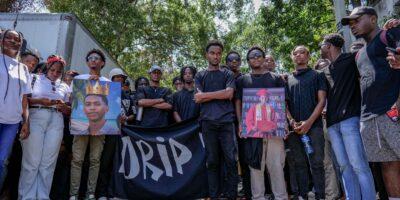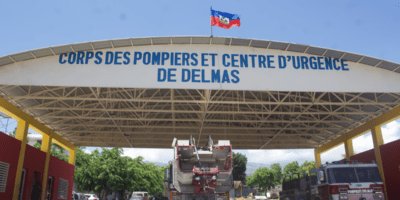According to two agents contacted by AyiboPost, the lack of adequate equipment to fight effectively means that certain police officers “choose survival over risk”
Haitian police officers deployed on the ground to fight gangs express reservations about the strategy of the security forces – Haitian and Kenyan – consisting of fighting gangs mainly from inside armored vehicles.
Fighting bandits, according to one of the agents who are part of the Departmental Unit for the Maintenance of Order (UDMO), requires confronting them on the ground, in neighborhoods sometimes connected by winding alleys inaccessible to armored vehicles.
According to the agent, remaining in the armored vehicles does not ensure the effectiveness of police operations.
“With this strategy, all we do is stave off the bandits. But then they come back and resume their attacks,” explains the agent.
Some police officers engage in “pye sòl” – which refers to police intervening by stepping out of the armored vehicle. However, he explains, “they know very well that it is dangerous when they face bandits who hide in dilapidated houses located in corridors. »
Remaining in the armored vehicles does not ensure the effectiveness of police operations.
According to two agents contacted by AyiboPost, the lack of adequate equipment to fight effectively means that some police officers “choose survival over risks”.
In December 2024, Mario Jean-Louis, a police officer from the 21st promotion of the PNH, was assassinated in Nazon.
An UDMO agent who worked with him in an armored vehicle deployed in the Nazon corridor explains to AyiboPost that Jean-Louis was killed while he tried to open the door of the armored vehicle to throw a tear gas grenade towards a building where, according to local residents, bandits were hiding.
Hit by several bullets, Mario Jean-Louis died in hospital.
“If the armored vehicle had been equipped with a launcher, he would not have died, because he would not have had to get out of the vehicle,” the police officer complains to AyiboPost.
He criticizes PNH officials who, according to him, do not demonstrate the desire to give the police adequate means to carry out their work.
“We want efficient equipment and more “seriousness” in the planning of interventions,” explains the agent.
An investigation published by AyiboPost in September 2024 reports friction between National Police agents and MMAS agents over the adoption of this same strategy by Kenyans.
A senior mission official contacted by AyiboPost cited two reasons for this strategy.
First, logistical problems which persist, according to the source.
“We are still waiting for certain tactical materials which should arrive,” explains the senior MMAS executive on condition of anonymity.
We want efficient equipment and more “seriousness” in the planning of interventions
This equipment, including drones, will make it possible to better plan interventions and have better control over targeted areas, according to the source.
“Sometimes, armed bandits hide on rooftops. It is therefore easy for a police officer who comes out of the armored vehicle to be killed in this scenario,” they explain to AyiboPost.
The other aspect, they continue, “is the fact that we try as much as possible to avoid innocent victims and other cases of human rights violations. »
In this vain, they note the presence of members of vigilance brigades and other citizens in the neighborhoods controlled by the bandits.
Other concerns exist within the mission, according to the source.
Sometimes armed bandits hide on rooftops. It is therefore easy for a police officer who comes out of the armored vehicle to be killed in this scenario.
“At the request of their respective governments, the other troops from other countries decided not to participate in interventions on the ground, but rather to ensure the security of strategic spaces,” they continue.
“We want that to change. We want more fighters to confront the gangs, in addition to equipment. »
These concerns take place in a context where the national police are facing a personnel shortage.
According to the United Nations Development Program (UNDP), in February 2022, the PNH had 15,474 police officers, including 1,712 female officers. According to the UNDP, this figure corresponds to a police/population ratio of 1.30 officers per 1,000 inhabitants. A ratio well below the internationally recognized standard of 2.2.
In this same document, the detachment of police officers from officials is cited among the challenges facing the police institution.
Present in the country for almost seven months, the foreign force, now made up of around 800 agents, is struggling to contain gang violence.
The gangs have already pushed more than a million people to flee their homes across the country, according to the latest data from the International Organization for Migration.
Read also: Kenyans complain about political instability in Haiti
Early in the morning of January 27, 2025, gangs attacked several neighborhoods in the town of Kenscoff, pushing dozens of families to flee their homes.
In recent years, due to the presence of gangs on the Martissant road, the Seguin road, passing through Kenscoff, has become the main route leading from Port-au-Prince to the Great South.
“If nothing changes in the security forces’ strategy, all of Port-au-Prince will fall,” adds the UDMO agent contacted by AyiboPost.
► AyiboPost is dedicated to providing accurate information. If you notice any mistake or error, please inform us at the following address : hey@ayibopost.com
Keep in touch with AyiboPost via:
► Our Channel Telegram : Click here
► Our Channel WhatsApp : Click here
► Our Community WhatsApp : Click here







Comments